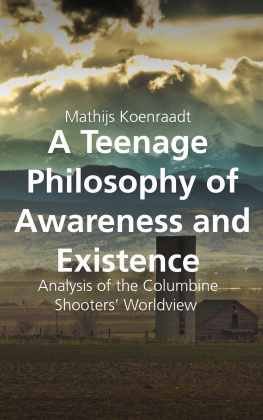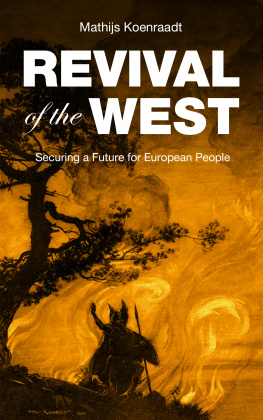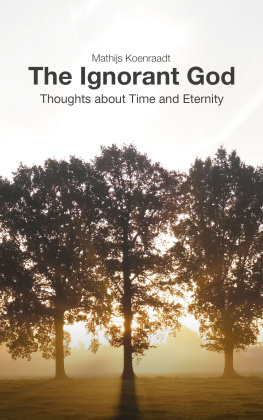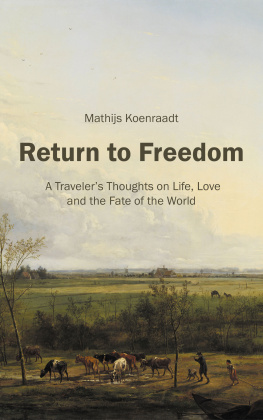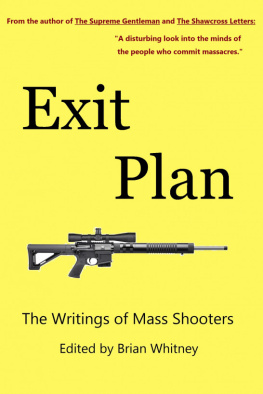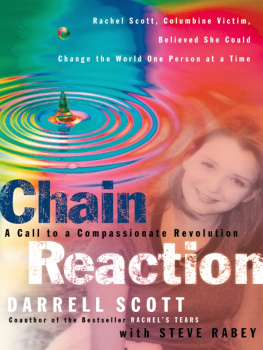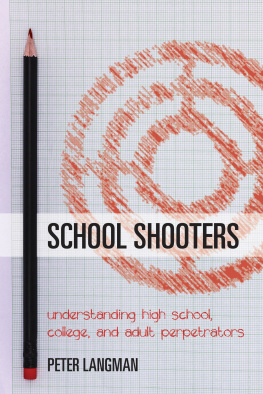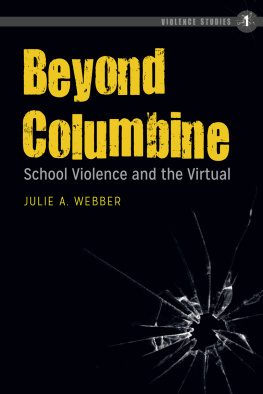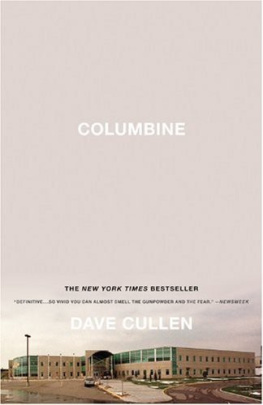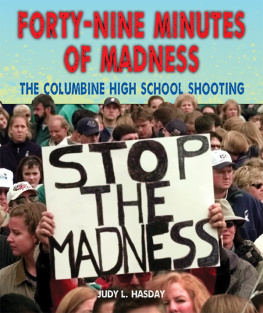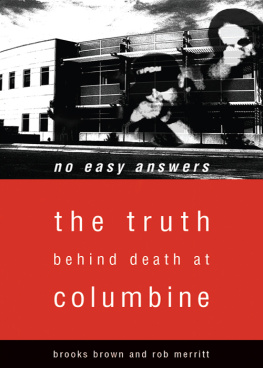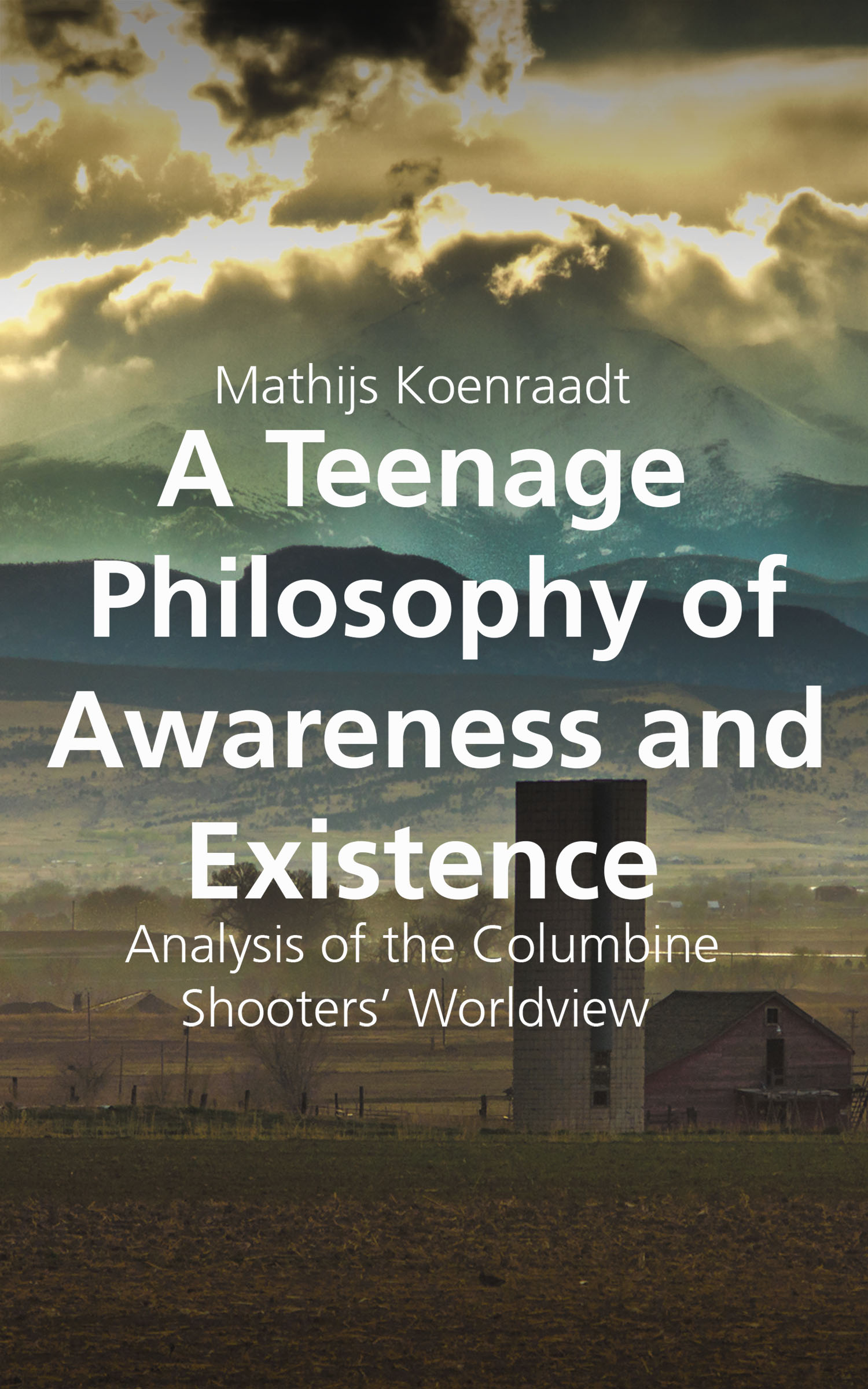A Teenage Philosophy of Awareness and Existence
Mathijs Koenraadt
A Teenage Philosophy of Awareness and Existence
Analysis of the Columbine Shooters Worldview
Second edition 2015 First published in The Netherlands 2014 Copyright 2014, 2015 by Mathijs Koenraadt
Published by Morningtime www.koenraadt.info
All rights reserved. No part of this publication may be reproduced, distributed, or transmitted in any form or by any means, including photocopying, recording, or other electronic or mechanical methods, without the prior written permission of the publisher, except in the case of brief quotations embodied in critical reviews and certain other noncommercial uses permitted by copyright law.
Paperback ISBN 978-1511520003 E-book ISBN 978-0463373781
Cover photography 2011 by Steven Bratman / CC BY 2.0
Contents
Part I
Preface
On April 20th, 1999, several hundreds of students flooded the Columbine High School cafeteria to have lunch. Two high school seniors waited outside near their cars, wearing black leather coats. Moments earlier they had visited the cafeteria and left behind two duffel bags that each contained a propane bomb with a detonator. While the bombs sizzled, the teenage men geared up and walked towards the school entrance. They intended to kill any fleeing victims running towards them. Eric Harris and Dylan Klebold would leave thirteen dead before taking their own lives. Without anyone noticing, they had planned the attack for nearly a year.
After the attacks, officers of the Jefferson County Police Office found a number of video tapes at the Harris residence. Dubbed the Basement Tapes , named after where they were recorded, the videos show how the teenagers explained their motives and bragged about how they had successfully hidden their elaborate preparations from both their peers and their parents.
I wrote this short book in defense of rebel ideas that either force us to think about the way that we organize our society, or that question our understanding of reality. In their writings, the Columbine High School shooters, Eric Harris and Dylan Klebold, showed their ability to have intelligent and original thoughts, highly critical of society and the world around them. If we as members of civilized societies wish to better understand the mind and motives of teenage mass murderers, we must begin by taking their ideas seriously. We should attempt to understand the world from their point view in order to see why they felt so left out in the first place.
However, I did not write this book to solicit compassion for the Columbine shooters and their actions. The horrific events shattered many lives. If Eric and Dylan had not taken their own lives, then they deserved long-term imprisonment.
But I have always believed that we should not dismiss other peoples ideas on the basis of their authors character. Someones character, behavior, appearance or criminal record often hinders our ability to understand. When we overzealously discard good ideas and great insights on such grounds, then we lose a chance to improve ourselves. History provides such examples. When Greek philosopher Socrates had asked too many critical questions about the meaning of life, the annoyed Athenians ultimately sentenced him to death.
As much as I disagree with harming human beings, I cannot deny that Eric Harriss and Dylan Klebolds insights positively surprised me. Eric criticized a society that suppresses peoples self-awareness so that they can be reduced to good little robots. Dylan discussed the idea that human thought induces reality as we perceive it, a theme not unfamiliar to the science of quantum mechanics. He believed that thoughts live in a separate dimension of reality, beyond what science can measure.
I came to write this book while I researched the Columbine massacre for a chapter in another book. I felt drawn to the ideas in the killers journals. At the time of the shootings, on April 20th, 1999, I was a few months short of a year their senior. The aftermath of the attack preoccupied my mind for weeks. Although I am European, they were a lot like me.
Their plans had been so elaborate, so well prepared, and while the media were looking for answers and blaming pop culture boogiemen, I traced down some of Erics personal websites that had not yet been taken down by the FBI. We had played the same video games such as Doom , Quake and Duke Nukem . We had listened to the same German rock bands such as Rammstein and KMFDM , and we had watched the same Hollywood movies like The Fifth Element and Event Horizon . Like Eric, I had also downloaded the infamous Anarchist Cookbook from the World Wide Web and I too had experimented with making pipe bombs, although unsuccessfully.
Despite an Atlantic abyss that separated us, we were children of the same European-American cultural uniformity.
For my research I read thousands of pages of the Columbine Documents that Jefferson County Sherrifs Office had released to the public in 2006. The documents include copies of the killers personal journals, school essays, day planners and various other documents. I decided to track down every single cultural reference I could find, such as Erics mention of Goethes Erlknig poem or his Shakespeare quotes. Besides literature, I also investigated the nineties culture and re-watched movies like Oliver Stones Natural Born Killers , whose script apparently influenced Erics plot for the attacks, sometimes word for word.
There is a reason for such in-depth analysis, beyond nineties nostalgia. One of Eric Harriss statements triggered me: I think people should learn more about what they are listening to. They need/should actually HEAR what they are listening to every day. People generally listen to music because it sounds good. Not many people listen to songs for the lyrics. These instructions pushed me to listen to the lyrics, see the symbolism and find the double-meanings, all in an attempt to truly understand what drove them.
What I found, buried deep among pages of hatred and depression, was a set of views, highly critical of the world, bordering on the philosophical. This little book starts your journey into the world of rebel ideas.
This is my first attempt at a philosophical analysis, admittedly a radical one. I chose the approach to define [the] project in terms of arguments and views that [I] basically agree with. I collected the most meaningful statements from the killers journals and searched for connections with mainstream philosophy, physics or other sources.
I improved the statements with proper punctuation, grammar and capitalization. Spelling, being a form of authority, was not much appreciated by Harris: I say, spell it how it sounds, its the [expletive] easiest way. For clarity, sometimes a word was added or removed, but without altering the statements meaning. These things were done to avoid distraction from the content.
Eric Harris on Awareness
Dont give yourselves to these unnatural men, machine men with machine minds and machine hearts! You are not machines! You are not cattle! You are men!
Charlie Chaplin
We all know that feeling when someone is watching over us, observing our every move. This is called self-consciousness, an acute sense of self-awareness. Eric Harris, however, wrote about self-awareness in a more philosophical manner, namely the way that his individual being related to society. Eric criticized society and was annoyed by other peoples behavior. He looked at people much like an anthropologist who observes the human herd.
Eric David Harris, born on April 9 th , 1981, wrote his journal entries in the year leading up to the attack, between March 10 th , 1998 and March 3 rd , 1999. Sometimes weeks or months apart, he wrote eighteen entries in total. They express various themes, ranging from practical matters that describe how he prepared for the attacks to themes of hatred and contempt of essentially everyone on Earth, including himself.

